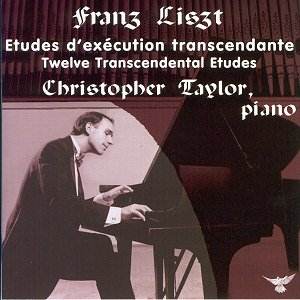I am sitting quietly at my keyboard trying to avoid flying
off into hysterical superlatives. Calmly, I will tell you this is one
of the three or four finest piano recordings Iíve ever heard. It ranks
high among the most outstanding half dozen recorded performances of this
work and is likely to retain that position for some time.
I have never heard a pianist play with such exquisite
control; he knows where every note should go and places it just there.
In the turbulent arpeggio passages the notes are placed in the foreground,
midground, and background, and remain exactly there throughout the phrase.
Piano students practice trills and try to get them
as even as possible. Piano virtuosi must learn to vary their trills,
because an absolutely perfect keyboard trill sounds rather like an old
fashioned telephone bell. Taylor plays some of them like that, because
that is what is appropriate. But trills sometimes need to lean on the
upper or lower note, or move back and forth between leaning one way
and leaning the other, sometimes in a regular or irregular or changing
pattern. Finally, it is often necessary to introduce a precise degree
of unevenness into a trill to achieve an interesting and expressive
texture. Taylor does all of these things exactly as, and when, they
should be done.
If a person does not feel this is their absolute favourite
performance, it would be in reference to an extremely high level of
criticism. Perhaps it is too ĎAmericaní in feeling. Perhaps one might
prefer a less precise performance with more ĎHungarian soul.í Perhaps
one should not play middle period Liszt with quite so much informed
awareness of late period Liszt. These are points which could be debated,
and I expect Taylor and his musicologist wife Denise Pilmer Taylor have
debated them. Whatever, if you should pick a single note from this performance
and ask why it was thus and not otherwise, I am sure Taylor could tell
you at as great a length as you desire.
This is wholly appropriate for a pianist who also has
a summa cum laude degree in mathematics from Harvard and who
writes not merely computer programs, but computer compiler programs.
He is currently Assistant Professor of Piano Performance at University
of Wisconsin.
The Berman recording remains a treasured document,
but the technical quality of neither his piano nor his recording can
match Taylorís. There is also some variance in interpretation, but Russian
versus American are probably equally distant from Hungarian, and probably
equally valid. Given a level playing field, Berman could probably take
Taylor, but the field is not level. The Arrau recording, once held to
be the finest version available ... well, compared A/B to Taylor, Arrau
sounds like Liberace. Certainly more impulse and more heaving passion,
but a rather flat dynamic. In the final analysis, Iím happy to have
all three, and perhaps you would be also.
Paul Shoemaker

![]() Christopher Taylor, Hamburg
Steinway D piano (Reid Schaefer, technician)
Christopher Taylor, Hamburg
Steinway D piano (Reid Schaefer, technician) ![]() LISZT DIGITAL LD005
[74.42]
LISZT DIGITAL LD005
[74.42]